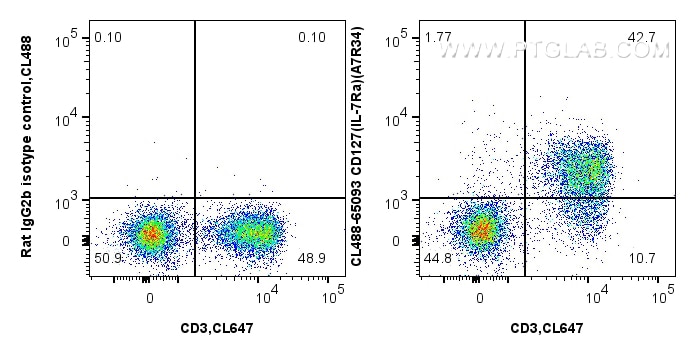IL-7Ra/CD127 Monoklonaler Antikörper
IL-7Ra/CD127 Monoklonal Antikörper für FC
Wirt / Isotyp
Ratte / IgG2a, kappa
Getestete Reaktivität
Maus
Anwendung
FC
Konjugation
CoraLite® Plus 488 Fluorescent Dye
CloneNo.
A7R34
Kat-Nr. : CL488-65093
Synonyme
Geprüfte Anwendungen
| Erfolgreiche Detektion in FC | Maus-Splenozyten |
Empfohlene Verdünnung
| Anwendung | Verdünnung |
|---|---|
| This reagent has been tested for flow cytometric analysis. It is recommended that this reagent should be titrated in each testing system to obtain optimal results. | |
| Sample-dependent, check data in validation data gallery | |
Produktinformation
CL488-65093 bindet in FC IL-7Ra/CD127 und zeigt Reaktivität mit Maus
| Getestete Reaktivität | Maus |
| Wirt / Isotyp | Ratte / IgG2a, kappa |
| Klonalität | Monoklonal |
| Typ | Antikörper |
| Immunogen | IL-7Ra-IgG1-Fusionsprotein |
| Vollständiger Name | interleukin 7 receptor |
| GenBank-Zugangsnummer | BC089571 |
| Gene symbol | CD127 |
| Gene ID (NCBI) | 16197 |
| Konjugation | CoraLite® Plus 488 Fluorescent Dye |
| Excitation/Emission maxima wavelengths | 493 nm / 522 nm |
| Form | Liquid |
| Reinigungsmethode | Affinitätsreinigung |
| Lagerungspuffer | PBS with 0.09% sodium azide and 0.5% BSA |
| Lagerungsbedingungen | Store at 2-8°C. Avoid exposure to light. Stable for one year after shipment. |
Hintergrundinformationen
CD127, also known as IL-7R subunit alpha (IL-7Rα), is a type I membrane glycoprotein expressed on thymocytes, B cell precursors, most T cells, and some lymphoid and myeloid cells (PMID: 8415665). IL-7R is a heterodimer composed of CD127 and IL-2Rγ (CD132), which is a common gamma chain shared by the receptors of various cytokines, including interleukins 2, 4, 7, 9, and 15 (PMID: 8266077; 9862091). IL-7R plays critical roles in lymphocyte development and homeostasis (PMID: 26336149). CD127 can also act as a receptor for thymic stromal lymphopoietin (TSLP) (PMID: 10974032).
Protokolle
| PRODUKTSPEZIFISCHE PROTOKOLLE | |
|---|---|
| FC protocol for CL Plus 488 IL-7Ra/CD127 antibody CL488-65093 | Download protocol |
| STANDARD-PROTOKOLLE | |
|---|---|
| Klicken Sie hier, um unsere Standardprotokolle anzuzeigen |


